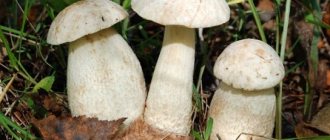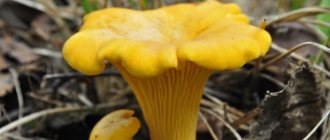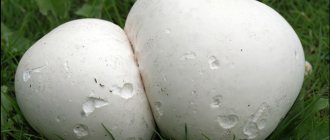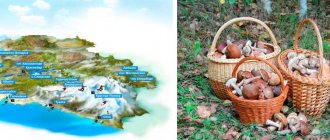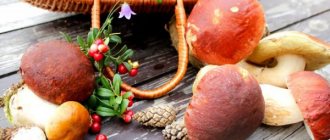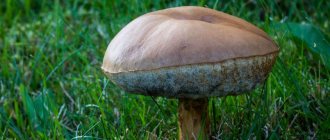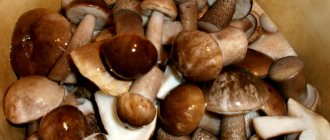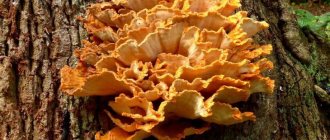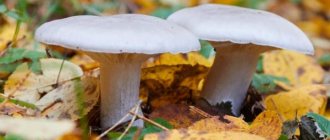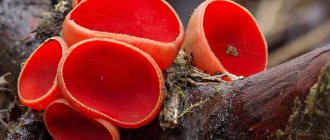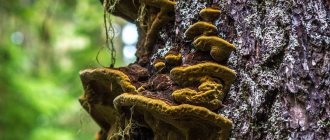tell friends
Mushrooms are a natural and tasty treat for almost every person. Remembering our childhood, when the whole family loved to go mushroom and berry picking, we had to get up early in order to have time to pick mushrooms and overtake the sluggish “competitors”. This is not the only reason, the morning forest simply breathes moisture, freshness and the cleanest air permeates everything around.
This process has always given me pleasure, since in the process of searching for mushrooms I could also enjoy other delights of forest gastronomy: berries and nuts. Taking a wicker basket, a knife, and smearing ourselves with various mosquito and tick repellents, we set off on 2-3 hour walks through the thick of the forest. Lined up in a row with a wooden cane, we carefully began to comb the area for mushrooms, trying not to lose sight of each other.
During the collection process, there was always an unspoken competition to see who would collect the most and who would have the most beautiful and noble mushrooms; porcini mushrooms and boletuses were especially valued - with their unusual property of turning blue at the point of cutting. Then I had no idea that there were different types of porcini mushrooms, much less the names of all edible mushrooms.
After picking mushrooms, we returned home with the spoils and began the process of sorting through the mushrooms: something went that same day to the frying pan with potatoes, delicious fried chanterelles; something was prepared and dried for the winter; they rolled something into jars (salted and pickled), mostly mushrooms growing on a tree - honey mushrooms.
As a rule, our weekend walks into the forest in order to search for caps sticking out of the grass began at the end of June and ended in August - September. It was especially good to go the next day after the rain, the catch was many times greater and the baskets were filled with younger and fresher ones.
So, what should you remember when going into the forest?
Twin mushrooms
Some mushroom lovers are afraid of being poisoned by false boletus.
Others generally doubt that false boletus mushrooms exist in reality. Which one is right? There really is no such species. All boletus “doubles” are edible and do not pose a health hazard. Let's see how this mushroom differs from each of them. Collecting boletuses is not difficult, since they grow in “families” and, if you see one, you can pick up a whole “cart” at once, if you’re lucky. You need to cut at the base so as not to damage the mycelium. You should not take only old mushrooms, as they will have time to spoil before the mushroom picker brings them home.
Some housewives are faced with the question of what to do with blue mushrooms that are different from the boletuses they saw in the photographs? After harvesting, boletus mushrooms must be processed and cooked immediately! If the mushrooms have lain for more than two days, even in the refrigerator, all that remains is to throw them away. If you plan to prepare them for salting, pickling or frying, you must first wash them, then clean them and remove possible worm damage, and then boil them in two waters. They do not wash it for drying, but they must clean it, preferably with a brush. Small fruit bodies are good to pickle or salt; large ones are preferably fried, stewed or dried. Mushrooms have an excellent taste and go well with other foods, in particular potatoes, buckwheat and rice. Good in soups and salads. You can “roll” mushroom spawn.
Boletuses in the forest
Boletus yellow-brown
It is considered the largest of the boletuses. In some adult specimens, the cap size reaches thirty centimeters in diameter! It has a yellow-brown hemispherical cap and a white leg covered with black-brown scales. This mushroom grows in mixed forests, where, in addition to aspens, birch and spruce predominate. Rocky, sandy or peaty soil is more favorable for it. A distinctive feature of this boletus is that its dense, white flesh turns pink at the break and then turns purple. The yellow-brown boletus appears in June and grows until October.
Boletus yellow-brown
Red boletus
Most often it grows in aspen forests from June to October. It has a red or brownish-red cap with white, dense flesh, which turns purple at the break and later almost black. The stem of the mushroom is white with almost the same scales.
Red boletus
White boletus
It is found in mixed forests where birch, aspen, and pine grow. It appears in late summer and autumn. This mushroom has a white cap and the same white stem. At the break, the flesh turns pink, and later becomes black-brown.
White boletus
Oak boletus
has a velvety red-brick cap. It grows in mixed forests dominated by aspens and oaks. All boletuses love edges, clearings, and damp places. Boletuses grow in shady places, hiding under fern leaves. Boletuses grow very quickly, but they deteriorate just as quickly. Therefore, young mushrooms are collected, which are called chelas. Young boletuses have a cap that looks like a thimble placed on a finger. Old boletuses, even if they are not wormy, are avoided, since they can begin to deteriorate while still in the basket.
Oak boletus
Moreover, mushrooms strongly absorb harmful substances, especially radioactive ones, both from the soil and from the air.
Taste and use in cooking
In terms of taste, aspen mushrooms are second only to the king of the forest - the porcini mushroom. Their flesh is denser than that of boletus and less juicy. They have a wonderful rich mushroom taste and aroma. The stem of mature fruiting bodies becomes too hard, so it is less often used for cooking. First courses of boletus are not often prepared, as the broth turns blue-black. Basically, they are fried, pickled, salted and dried, and for pickling it is better to use younger specimens, and it is optimal to dry or fry mature ones.
The boletus pulp spoils quickly, so it is better to collect young fruiting bodies. They are also rarely used for making soups due to darkening during heat treatment. It is recommended to cook boletus mushrooms together with other types of mushrooms, since their taste is not very pronounced. This type can be fried, pickled, dried, salted. Boletus mushrooms make an excellent filling for baked goods, pancakes, dumplings, etc.
When to collect
All of the above types of boletus can form fruiting bodies from late May to mid-November, until the first frost. Periods of stable fruiting: August - October. However, experienced mushroom pickers always predict the time of appearance of the first representatives of boletaceae, depending on many conditions: whether last year was a “mushroom year” (as they say, one year does not coincide), how dry the last summer was, and how frosty the last winter was. Again, it is known that periods of high mushroom yield in a certain pattern alternate with periods of complete absence of mushrooms.
Did you know? The people still maintain the belief that a too mushroom year foreshadows war. Perhaps this is just a coincidence, but in the fall of 2014, Ukrainian mushroom pickers returned from a “quiet hunt” with truly unprecedented harvests...
During the collection process, you should remember that boletus is a very “vulnerable” mushroom.
It will be interesting to know how to distinguish toadstool and poisonous mushrooms growing on trees from edible mushrooms and boletus mushrooms.
Product Application
Like most other mushrooms, boletus is an excellent source of protein. In addition, it contains a large amount of vitamins, as well as micro- and macroelements. Since ancient times, boletus mushrooms have been used as food. Their calorie content is low, only 20 kcal per 100 grams of product, but in terms of nutritional qualities, birch mushrooms are superior to many other mushrooms. During cooking, the mushroom darkens, but this does not affect its taste. Boletus mushrooms are fried, boiled, canned and dried, pies are baked with them and holiday snacks are made based on them.
How to identify false boletus
In conclusion, let’s consider an important question for a novice mushroom picker: how to distinguish a real boletus from its double?
To avoid mistakes, you should remember a few simple rules. Firstly, boletus flowers do not like light. If you see a similar mushroom growing in an open place, this is already a reason for doubt.
Secondly, false boletus usually tastes bitter, so worms do not eat them. Examine the mushroom. If it is perfectly clean, with veins on the legs in the form of blood vessels, then most likely you are holding an inedible mushroom in your hands.
Thirdly, a proven way to determine whether it is a real boletus or not is to break the cap. Here the false mushroom will immediately give itself away, starting to noticeably turn blue. And if after this action the flesh has practically not changed, feel free to put the mushroom in the basket.
How to distinguish from poisonous counterparts
The boletus has a poisonous counterpart called the false boletus or gall mushroom. Outwardly, it is practically no different from boletus, but has a pronounced bitter taste. It is quite difficult to distinguish it from a true mushroom, but it is possible.
Important! The poisonous twin of the boletus is not deadly, however, if you doubt the correctness of the choice, it is better not to touch it with your bare hands when examining it.
An experienced mushroom picker uses the following steps to recognize gall fungus:
- Place of growth. The Antipode chooses a habitat near stumps, dry trees, ditches and in dark forests with a predominance of coniferous trees.
- State. False boletus is so bitter that neither worms nor insects deign to pay attention to it, so it has no defects, wormholes or other flaws.
- Hat and leg. They are very similar to the noble representative of the third kingdom, however, upon careful examination, some differences can be identified: they are larger than the original; the leg is dotted not with a scaly, but with a mesh pattern, reminiscent of the human vascular system; The pulp has a pinkish oily texture.
- Physical impact. When pressed or cut, the flesh takes on a pink tint, while in true boletus the color of the flesh remains almost unchanged, only slightly darkening.
Types of boletuses
Yellow-brown (red-brown) boletus
Yellow-brown boletus (Leccinum versipelle)
The largest among all representatives of these mushrooms. The cap can reach 30 cm in diameter. Often inexperienced mushroom pickers are afraid and pass by such a boletus, which is completely in vain; it is quite easy to distinguish it from a false one. The mushroom must be broken, in the damaged area it should first acquire a pinkish tint, and then purple.
Red boletus
Red boletus
This mushroom is much easier to recognize. Its cap has a deep red color and is most noticeable among the foliage, even from afar. The pulp is fleshy and very dense. The legs are white with small scales. Mushroom pickers should not be afraid of unusual changes when collecting this species. When the mushroom is cut, the damaged area acquires a blue tint and then turns black.
Pine boletus
Pine boletus (Leccinum vulpinum)
The diameter of the cap of this type of mushroom can reach 15 cm. The color is brown-red, and over time it acquires a crimson hue, which does not even look natural. Externally it has a velvety appearance. The peculiarity of the mushroom is to change the color of the pulp. This does not depend on damage; this process occurs on its own during growth and maturation.
White boletus
White boletus
The name of the mushroom speaks for itself about its color. Both their cap and stem are pure white. Although this applies only to young representatives of mushrooms. Large mushrooms are gray in color. In a broken place they acquire a blue tint, which soon turns black.
Painted-legged boletus
Colored-legged boletus
This mushroom is slightly different from other boletuses. It is characterized by a pink cap, which can be either flat or convex. Its leg is covered with pinkish scales. The color at the base is rich yellow, gradually turning into white and pink towards the top. This variety is especially loved by insects and various kinds of worms.
Redhead oak boletus
Oak boletus (Leccinum vulpinum)
Young representatives of this species are very unusual. The hat looks like a thimble placed on a finger. Its edges fit tightly to the stem, giving the mushroom a spherical shape. Over time, the diameter of the cap can increase to 30 centimeters. Mushroom pickers are very fond of the Redhead mushroom, it is tasty and looks aesthetically pleasing. In older mushrooms, the cap takes on a cushion shape. The color of the cap becomes red mixed with orange tones. Mature mushrooms are characterized by a velvety texture. The leg is white with reddish scales and shaped like a cylinder. It can reach a height of 20 cm and a thickness of up to 5 cm. The scales on the legs quickly darken, which indicates the growth and maturity of the mushroom. The lifespan of this species is very short. Only 11 days. The older you get, the more decrepit the mushroom pulp becomes.
Spruce boletus
Spruce boletus (Leccinum peccinum)
The color of the cap is brown-red. Can reach up to 10 cm in diameter. The skin is not smooth, it hangs slightly from the base, forming a slight overlap over the stem. The cap is covered with small scales, slightly lighter than the main tone. The length of the leg reaches 13 cm, and the thickness reaches three. The mushroom got its name due to the places where it germinates. They can be found in spruce, coniferous forests, and oak forests. These mushrooms grow in large groups.
Black-scaled boletus
Black-scaled boletus
The habitat of this species is solitary aspen trees. The color of the cap has a reddish-brick tint. Young individuals have a velvety, matte cap. As she ages, she becomes “naked.” The shape at first resembles a ball, and as it grows it becomes more like a pillow. The stems of young mushrooms are white and gradually turn gray with an olive tint. The height of the leg can reach 18 cm. It is covered with reddish scales. When cut, the mushroom immediately acquires a purple color, and after a while it changes to black.
There are other types of boletuses, described earlier - these are the main ones.
Boletus and boletus: photos of differences
The boletus is an edible cap mushroom. Its cap has different colors. There are specimens of white, brown, grayish and almost black color. The shape of the cap is hemispherical, over time it takes on a pillow-like shape. Its size is up to 15 cm, after rains the surface becomes slimy.
The leg is white, slightly thickened. It contains oblong scales of dark or light color. The diameter of the stem is up to 3 cm, its length reaches 15 cm. The flesh of the boletus is white and does not change after cutting. The taste and smell are pleasant, characteristic of mushrooms.
Boletus is an edible variety. It is characterized by a red-brown cap measuring from 5 to 15 cm. Its shape is hemispherical, the edges are pressed to the stem. Over time, it acquires a cushion-shaped convex shape. The skin is orange, red, brown, and in some specimens it is white.
The leg is from 5 to 15 cm high, its thickness reaches 5 cm. The surface is grayish, with numerous brown scales. The pulp is dense, fleshy, and becomes softer as it grows. After cutting, the color changes from white to bluish, gradually turning black.
How is boletus useful?
The special value of boletus mushrooms is that they contain a well-balanced protein, including leucine, tyrosine, arginine, and glutamine.
Boletyozovik has a sufficient supply of vitamins - B, C, D, PP and E.
Thanks to dietary fiber, boletus absorbs and then removes various toxins from the body.
Boletus is an excellent antioxidant.
Boletus mushrooms are effective for treating kidney pathologies, the nervous system, and regulating blood sugar. They are beneficial for the health of the skin and mucous membranes. Due to the large amount of phosphoric acid, which is involved in the construction of enzymes, boletus mushrooms are a valuable product for improving the functioning of the musculoskeletal system.
Benefits and harms
Boletuses are characterized by a properly balanced amount of nutrients. Mushrooms contain many microelements and also contain vitamins. For inflammatory diseases and anemia, it is useful to consume such mushrooms. They help the body heal wounds and stimulate the immune system after infectious diseases. Scientists have even proven that dried aspen boletuses cleanse blood vessels, lowering blood cholesterol levels.
But boletus, like other mushrooms, is quite difficult to digest. Because of this, there is a load on organs such as the liver and kidneys. Those who have problems with them should avoid mushrooms. And from spoiled, wormy and old boletuses you can get poisoned.
Poisoning and first aid
The pulp of the false mushroom contains resinous substances, which have an irritating effect on the mucous membrane of the digestive tract. Bitter poisoning occurs in rare cases; due to its strong bitterness, it is impossible to eat it in large quantities. The risk increases with accidental use in pickles and marinades, where the bitterness is masked by spices.
Signs of poisoning may be absent for 30 minutes to 3 hours. Then characteristic symptoms appear:
- pain in the abdominal area;
- nausea;
- diarrhea;
- vomit.
The intensity of symptoms depends on the characteristics of the organism. Dehydration may develop due to vomiting and diarrhea.
Even with mild symptoms of intoxication, it is recommended to consult a doctor (call an ambulance) to exclude poisoning from other more dangerous types of mushrooms, for example, toadstool.
First aid includes:
- Gastric lavage to prevent further absorption of toxins. Vomiting is caused after drinking 2-3 glasses of salted water. The procedure is repeated until the stomach is completely cleansed.
- Taking intestinal sorbents to remove toxic substances.
Further treatment, determined by the attending physician, is aimed at restoring the water-salt balance. On the first day, food intake is excluded; subsequently, the diet includes easily digestible foods (porridge, lean meat, stewed vegetables). The prognosis for bitter bitter poisoning is favorable, the body recovers within a few days without the development of complicating consequences.
Knowledge of the external characteristics of the gall fungus will allow you to identify it in time, avoiding unpleasant consequences.
Symptoms of poisoning by false boletus
When people eat toadstool, they do not feel anything until the poison penetrates deep into the brain tissue and organs. A person vomits after about 12 hours, suffers from diarrhea, and the body becomes dehydrated. Then a short remission occurs for 2-3 days. On days 3-5 the liver and kidneys fail. If you eat a lot of toadstools, the course of intoxication is more acute and accelerates.
It is almost impossible to get poisoned by gall fungus. Its pungent taste turns off even extreme experimenters. And one gall mushroom, when cooked, will ruin a whole basket of boletus mushrooms; the cook will throw away the dish after trying it. The clinical picture is the same as for any poisoning, but without death.
Use
Since the taste of the delicious fruiting bodies is second only to porcini mushrooms, mushrooms are used truly everywhere in cooking. Boiled mushrooms are added to salads and snacks, birch and aspen mushrooms are fried and eaten with potatoes and meat, their legs and caps add an unusual and very pleasant taste to hot soups. Also, the fruiting bodies are often dried and pickled for the winter - you can enjoy the taste of the fruit even in the cold winter months.
Edible fruit bodies do not require special processing before cooking. There is no need to soak them, just clean the mushrooms from debris, remove the skin from the stem and cut off the tubular layer on the cap. After this, the raw materials are washed and immediately sent to boil in salted water for 30-40 minutes, and after the first 5 minutes of cooking, the water is drained and replaced with fresh water.
In addition to cooking, birch and aspen trees are used for medicinal purposes. They are suggested to be used in many folk health recipes. It is believed that infusions and tinctures of these mushrooms:
- have a beneficial effect on kidney health;
- help get rid of inflammatory diseases;
- have a good effect on diabetes;
- have a calming and relaxing effect.
Low-calorie fats can be found as part of weight loss diets. Due to their high protein content, aspen and birch trees fill you up well and help get rid of hunger. But it is impossible to gain weight on mushrooms if you eat properly, so for weight loss the effect will only be positive.
What inedible mushroom can boletus be confused with?
The boletus is very unique in its appearance, and therefore it is quite difficult to confuse it with other mushrooms. But inexperienced mushroom pickers may still have some difficulties identifying it. In nature, there is perhaps only one inedible mushroom, which has some similarities with boletus, and it is called gall mushroom
(Tylopilus felleus).
The gall mushroom is not poisonous, it is simply inedible due to the very bitter taste of the pulp. Among the main differences between this mushroom and boletus, it is worth highlighting the brown cap, a tubular layer that has a pinkish tint in adult mushrooms, as well as a stalk on which there are no scales, but often there is a mesh pattern. When cut, the mushroom does not darken; only occasionally the flesh may develop a reddish tint. The gall fungus is quite widespread in Russia; it grows in coniferous and deciduous forests, and likes to appear at the base of trees. Most often, the gall mushroom is confused with boletus or porcini mushroom, but it does not have much resemblance to boletus, you can see this for yourself by looking at its photo.
Edible mushroom very similar to boletus
The genus Leccinum includes a considerable number of mushrooms, among which there are not only boletuses, but also boletus mushrooms. Exactly one of the types of boletus, and specifically the harsh boletus
(Leccinum duriusculum) is very similar to boletus in many ways. This mushroom forms mycorrhiza with aspens and poplars, has a dense pulp structure that darkens when cut, there are often bluish spots at the base of its stem, and in general its appearance resembles a typical aspen boletus.
Have you noticed how much these mushrooms have in common? Well, now it’s worth talking about the differences. The first thing that catches your eye is the cap; the cap of the boletus boletus is grey-brown or brown; similar colors can only be found in the spruce or oak boletus. When cut, the boletus pulp does not darken immediately; initially it acquires a reddish tint and only later becomes almost black.
The tough boletus is rarely wormy. This is associated primarily with its dense pulp. It bears the greatest resemblance to boletuses at a young age, when its cap has not yet opened. In terms of nutritional value, this boletus is not inferior to boletus.
Well, my story about boletuses can be considered complete. I tried to reflect in the article the most complete information about these wonderful mushrooms, using personal knowledge, books and the Internet. I hope you found it interesting!
Types of mushrooms of the Boletaceae family
Where does such external diversity of boletus come from? There are several varieties of this mushroom:
The cap of the common boletus has a semi-convex shape. The leg is whitish, cylindrical, with pronounced scales, 4 cm in diameter and 17 cm in length, at the point of cut it begins to turn pink.
The gray boletus has an alternative name: hornbeam. Its cap is brown in color, and the yellowish flesh, when broken, begins to turn blue (to a violet hue) and then turn black. Longitudinal fibers are clearly visible on the stalk.
The marsh boletus, which loves damp places, is distinguished by a brown cap and a light-colored leg. To test the mushroom for edibility, break the stem: it should not turn blue.
Despite their bright color (from pink to bright orange and brown), multi-colored boletus mushrooms are not very popular among mushroom pickers. The reasons for this are the not very pleasant taste and difficulties in preparation.
The black boletus stands out among its relatives due to its corresponding color. Large tubes in the porous layer and black scales on the legs are its distinctive features.
Pink boletus is found in North America and Europe. So named for the peculiarity of the pulp, which begins to turn pink in fracture zones.
The white boletus is distinguished by the corresponding cap color and creamy flesh. This species is so unpretentious that it can be grown in the garden.
Stiff boletus grows in mixed forests. It is distinguished by a cap in a palette from gray to pale purple on a high stem. This species is loved by mushroom pickers, since the tough flesh is not very attractive to worms. And the sweetish taste of the mushroom makes it an excellent addition to the dinner table.
To navigate such a variety of boletus mushrooms, the mushroom picker needs to take into account some features.
Firstly, it is necessary to take into account the area and what types of mushrooms grow there. Secondly, it wouldn’t hurt to take a photo of the boletus mushroom with you, so as not to confuse the edible mushroom with its double.
Characteristics
Boletus mushrooms are very similar in description and taste to porcini mushrooms, and they are also the closest relatives of boletus mushrooms. And yet there are some differences, the main one of which is that the boletus mushroom turns black when cooked, while the white one does not change its noble shade.
Babies grow very quickly; in favorable conditions they can stretch up to 4 cm per day. By about 5-6 days, the fungus has fully matured, after which the active aging process begins. For this reason, obabki should not be stored unprocessed, even in the refrigerator. Once collected, they should be immediately peeled and boiled or frozen.
hat
The cap of a young boletus has a convex spherical shape. As the mushroom matures, it flattens out a little, becoming cushion-shaped, but even the old ones have a convex hat. The surface of the cap is smooth; after rain and in a humid environment, the thin skin becomes slimy, almost as “snotty” as that of an oil can.
Pulp
Dense, white, may turn slightly pink when cut. When broken, it emits a pleasant mushroom aroma. The lower part of the cap - the hymenophore - is tubular, white or gray. During cooking, this part breaks down into fibers and will spoil the appearance of the dish, so it is usually removed. It is easily separated from the top layer. In an old mushroom, the hymenophore is darker, and the flesh is more porous and watery. In addition, with age, the fruiting body quickly becomes wormy.
Leg
The strong, long white stem is not particularly valuable to culinary experts due to its fibrous structure. The legs of old boletus mushrooms become especially tough.
How to cook
Since boletus is one of the three most delicious mushrooms, it is clear that a large number of dishes are prepared from them. These mushrooms are consumed immediately or stored for the winter. Either way, they are so good that it is worth trying them fried, marinated and in various dishes.
To prepare it, we need a standard set: potatoes, onions, carrots, as well as herbs, salt, butter and, of course, boletus.
Redheads are cleaned, washed, dried on a napkin. Then they need to be cut into slices and thrown into boiling water. You will have to cook them for 15 minutes, constantly removing the foam on the surface. If the mushrooms are dried, then you need to cook for half an hour. Then you can add onions, fried until golden brown in butter. At the same time, you can add chopped potatoes, preferably young ones. After 25 minutes, it’s time to add spices, and after another 5 minutes, turn off the soup. Before serving, it is advisable to let it brew for another 10-15 minutes.
Fried
Frying boletus mushrooms is very simple, but they will turn out incredibly tasty. To do this you will need half a kilogram of mushrooms, butter and vegetable oil, onion, herbs, sour cream, salt and pepper.
First, the onions are fried in butter and vegetable oil, then peeled, washed and chopped mushrooms are added to it. Simmer everything until the liquid evaporates. After this, fry the boletus until golden brown, about 10 minutes. Add spices and sour cream, mix everything. Now keep it on low heat for another 5 minutes with the lid on. You can serve with any side dish of your choice.
Pickled
There is no tastier winter snack than beautiful pickled boletus. To prepare these, you need to wash the mushrooms well, clear them of forest debris, and then rinse them well.
If the mushrooms are small and young, you can leave them whole, then they will look very beautiful on the table. It is still better to cut large mushrooms into pieces.
Cook the redheads for 10 minutes, skimming off the foam. Then drain the liquid and add marinade.
This is how he prepares. For 1 liter of water you will need:
- salt (1 tbsp.),
- sugar (3 tsp),
- bay leaf (2 pcs.),
- allspice (5 pcs.),
- black peppercorns (5 pcs.),
- the same number of cloves and garlic cloves.
All this is combined and cooked for 10 minutes. Then pour the mushrooms into the marinade and cook for about 20 minutes. At the very end, after removing the pan from the heat, add 2 tsp to the mushrooms. vinegar.
Boletuses are packed tightly into sterilized jars along with brine. You can pour 2 tbsp on top. l. vegetable oil, pre-boiled.
This will extend the shelf life of the mushrooms. You need to roll up with hot lids. It is necessary to cool for a long time, wrapping the jars in a blanket.
Then the mushrooms should be served with chopped onions, adding a couple of drops of vegetable oil on top.
Freezing
To properly freeze boletus mushrooms, you need to follow a few simple rules. The first thing is to correctly select and clean the redheads. This means that the mushrooms should be no more than a day old. They must be thoroughly cleaned of debris.
It is important to wash the boletus well, but do not soak it, so as not to gain excess moisture. We select only beautiful young mushrooms so that they are firm
Secondly, you can freeze fresh mushrooms. To do this, simply lay them out entirely on a flat surface, such as a board or tray, and put them in the freezer, in the quick-freezing section. Only after this we put it into bags and containers. It is advisable to defrost such mushrooms at low temperatures - in the refrigerator. This way they will not lose their aroma, they will be as if they were fresh from the forest.
Third, freeze the prepared mushrooms. You can store boiled or stewed boletus this way. In this case, you only need to cook for about 5 minutes. Then these mushrooms are good to fry
It is important to drain the liquid and only then freeze it. Can be immediately in bags, but must be laid out in portions
Some people freeze fried boletus. They are fried until the moisture has completely evaporated, about 20 minutes. Then they are put in bags and sent to the freezer.
These are such beautiful and delicious mushrooms - boletus. Collect them and cook with joy!
Multi-colored boletus mushroom
Category: edible.
The cap of the multi-colored boletus (Leccinum variicolor) (diameter 5-12 cm) is gray or brown, with yellow or gray markings. It can be brick, orange, beige, pinkish. It has the shape of a hemisphere with the skin slightly overhanging at the edges. In hot weather it feels dry to the touch, in humid weather it can be slightly slimy.
Leg (height 9-19 cm): white or light gray, often with small scales. It tapers from bottom to top and has a cylindrical shape. Tubular layer: grayish in color.
The pulp: pink in the cap, bluish in the tubular layer, and pink or green in the stem. In young mushrooms it is dense, but becomes looser over time. Has a sour smell.
Doubles: none.
When it grows: from late June to mid-September, often found in southern Russia.
Where to find: in deciduous forests, especially often near birches, oaks and poplars.
Eating: only young mushrooms, as old ones are tough. In extreme cases, you can use hats. Multi-colored boletus is very tasty dried and pickled.
Use in folk medicine: not used.
Other names: multi-colored obabok.
Share this article:
Description
At first the cap is hemispherical, its diameter is 5–15 cm. Over time it flattens. The cover of the cap is gray-light brown or gray-reddish brown, later losing shades, becoming brown, smooth, hairless, dry and rather slimy in humid conditions.
In young specimens the pores are white, later turning gray. In older boletuses, the pores on the villi protrude, and the stems around them are strongly pressed in. The pore coating is easily removed from the mushroom cap.
The stalk is thin and tapers upward, 5–15 cm long and 1–3.5 cm wide, covered with scales. They are white, dark to black. The main mycelium is white. The pulp is whitish, later gray-white, and retains its color when broken.
In young individuals, the body flesh of the fungus is relatively dense, but very soon becomes spongy, loose and retains water, especially in humid conditions. Turns black after cooking.
Hornbeam - description of where it grows, the toxicity of the mushroom
Hornbeam is named after the hornbeam tree near which it most often grows. But it also has other names - gray or elm boletus, gray boletus. This mushroom is so similar to boletus that mushroom pickers cannot always distinguish them.
Characteristics of appearance
The hornbeam belongs to the Boletaceae family. His family is obabok.
Young mushrooms have a hemispherical cap shape, with folded edges. At a more mature age, the cap takes on a cushion shape. The surface is slightly wrinkled and uneven. The porous layer is up to 3 cm. The skin is matte and dry, but if it rains, it immediately becomes shiny and looks watery. Therefore, in comparison with boletus, it loses due to the less high-quality density of the cap. If the mushroom is overripe, the skin completely shrinks, and then the flesh of the cap and tubes are visible underneath.
The flesh of a young specimen is usually white and soft. But the older generation of hornbeams acquires rigidity with age, which makes them significantly different from boletus. When the mushroom is cut, it darkens to a pink-purple color and then becomes dark gray. But the aroma and taste of the mushroom are pleasant.
The color of the leg is grayish, but at the bottom it changes to brownish. It has a cylindrical shape, which becomes thicker closer to the ground. The pulp in it is fibrous. The thickness of the leg is on average 4 cm, height is from 5 to 13 cm. The porous layer is free. It has a small recess located at the leg.
The shape of the spores is spindle-shaped, and the spore powder has a brown tint. The pores are very small with an angular-rounded shape, their surface is white or sandy. The tubes are narrow, have a soft consistency with a watery structure.
Where can you find a hornbeam?
Of course, where hornbeams grow, you can also find hornbeam. But since these trees belong to the birch genus, gray boletus trees are often found in birch groves. These mushrooms also grow near other deciduous trees, for example, hazel and poplar.
The most common habitats are the northern zones of Russia and Asia, the Caucasus. You can collect hornbeam as early as June, and its collection ends in October.
Hornbeam as a food product
This mushroom is classified as edible, and its taste is very similar to boletus. But due to the fact that its pulp is less dense, it cannot be stored for a long time and quickly deteriorates.
These mushrooms are especially loved by worms, so many cannot be eaten due to the fact that they are eaten away. After collecting, you should carefully sort them out at home and leave only fresh and healthy ones. If some parts are darker in color, this may be evidence of rotting, which is dangerous not only to health, but also to life.
Hornbeam is used fresh to fry and boil, dried, soaked in vinegar and salt, and pickled. To prepare various dishes, recipes that are applicable to boletus are used.
Similar mushrooms
The hornbeam has similarities (and quite a lot) with both some edible mushrooms and those that are dangerous to humans.
The gall mushroom is also a double of the hornbeam, but this is its “antipode”, as it is considered almost poisonous. It is not suitable for food because it has a bitter taste. Even if you try to remove the bitterness from him, nothing will work, it will only intensify. Such mushrooms most often grow in forests with coniferous vegetation, as well as on sandy soils. Their period of existence is from July to October. Their cap is convex, with an average diameter of 10 cm. The surface of the gall fungus is smooth and dry. The color is brown or brown. The pulp is white, thick. When it is cut, it takes on a pink tint. It has no smell, but you shouldn't try it: it is very bitter. The leg can be up to 7 cm in length, from 1 to 3 cm in width. It differs in that it is swollen and dark brown or creamy-ochre, with a mesh pattern visible.
About mushrooms, beneficial properties
At one time, mushroom products were very popular and were widely exported to Western European countries. Merchants exported mushroom products in barrels, which were served as a delicacy in the best restaurants in France. Camelina mushrooms were exported; they were the same size, no larger than a five-kopeck coin. Nowadays, truffles, which grow underground and are characterized by a fleshy or gristly consistency, are an exquisite delicacy.
The nutritional value of mushrooms has long been recognized; they are very useful due to the content of various minerals, vitamins and vegetable proteins. In terms of their nutritional value, mushrooms occupy a well-deserved place between meat and vegetables; By consuming them, we add variety to our diet. And summer is the best time to charge the body with additional vitamins, such as: B1 B2, B6, D, N, PP, etc., their content is higher than in vegetables, especially in fresh mushrooms collected in an environmentally friendly area.
Thanks to the variety of minerals, our body can replenish its reserves with substances such as copper, iodine, zinc, arsenic, phosphorus, iron, etc., they play an important role for our digestion and cell structure.
Nutritional value table , content in % by weight
| Water | Protein | Fats | Carbohydrates | Cellulose | Minerals | Energy value per 100 g | |
| Fresh mushrooms | |||||||
| white | 87 | 5,5 | 0,5 | 3,1 | 3 | 0,9 | 167 |
| boletus | 88 | 4,6 | 0,8 | 2,2 | 3 | 0,9 | 150 |
| boletus | 92 | 2 | 0,3 | 3,5 | 3,5 | 0,9 | 146 |
| boletus | 88 | 5 | 0,6 | 2,5 | 1,6 | 0,6 | 104 |
| chanterelles | 91,4 | 2,6 | 0,4 | 3,8 | 1 | 0,8 | 125 |
| honey mushrooms | 90 | 2 | 0,5 | 4 | 2,7 | 0,8 | 121 |
| saffron milk caps | 90 | 3 | 0,7 | 2,4 | 3,2 | 0,7 | 121 |
| morels | 90 | 3,7 | 0,5 | 4 | 0,8 | 1 | 150 |
| russula | 91 | 2,5 | 0,5 | 4 | 3,5 | 0,8 | 92 |
| Dried mushrooms | |||||||
| white | 13 | 36 | 4 | 23,5 | 17 | 6,5 | 1174 |
| boletus | 13 | 38 | 5 | 21,5 | 15 | 7,5 | 1212 |
| For comparison | |||||||
| White cabbage | 90 | 2 | 0,3 | 5 | 1 | 1,2 | 125 |
| Beef II grade | 74 | 21 | 4 | — | — | 1 | 506 |
| Fish (perch) | 78,7 | 19 | 1 | — | — | 1,3 | 351 |
As can be seen from the comparative table, mushrooms are closer in composition to meat products, but the mushroom itself and its components have different nutritional value. For example: strong (fleshy) white from a dry and clean forest is valued higher than the same, but more sluggish one collected in a wetland. The caps (umbrella) of mushrooms contain more nutrients than the dense, but poorer stem.
All components of the noble mushroom can be eaten. But, remember, a younger and stronger mushroom (both the cap and the stem) is recommended for consumption; old and decaying mushrooms begin to accumulate dangerous, poisonous decay products, which can cause stomach upset, a sharp decline in cardiac activity and generally have a negative impact on human health. Therefore, you need to very carefully choose the mushrooms that you put in your basket, and after you return from mushroom hunting, additionally sort through the harvest and make sure they are reliable, rinse them well, after which the mushrooms can be sent for processing, harvesting and eaten!
gribnoi-mir.ru
If you decide not to pick mushrooms yourself, but to buy them from hand or in a store, then remember - Mushrooms absorb everything that is in the air and it is impossible to unambiguously answer the question of where certain mushrooms were collected, but to be more confident in your When choosing, buy them in trusted places and where the products sold are controlled, for example at the local market. There, at least some way of checking the mushrooms, it is not safe to buy mushrooms from sellers along the road.
If, having found a mushroom, you are not sure of its nobleness, you cannot definitely say whether it is edible or not, you should not put it in the basket, it is better to continue your search and collect only those mushrooms that you are sure of. And if you take with you a mushroom picker’s guide or, worse, a book, it will take a lot of time and, as a result, effort to find the right mushroom and compare it with the picture. Noble and edible fungi are easy to identify if you limit yourself to the first taste category, the highest grade!
At the edge of the forest, the harvest is often especially abundant!
Obabok and boletus - are they the same thing or not?
According to the classification, boletus mushrooms are indeed little birds; they are part of the genus with that name. But at the same time, not every mushroom is an ordinary boletus, because other types of mushrooms are also called by this word.
In particular, the obobkaks include:
- boletus - gray, or hornbeam, harsh, marshy, black, pinkish and multi-colored;
- boletus - black-scaled, red, white, yellow-brown;
- redheads - spruce, pine and oak;
- Far Eastern and blackening obobki.
All these mushrooms belong to the edible or conditionally edible categories, have similar structural features, but can differ greatly in color.
Interesting facts about the name "Boletus"
Of course, the fact of the origin of the name boletus can hardly be called interesting, because it is obvious. However, what is interesting is that among the popular names of the mushroom there are other variants that are very common. Among them, for example:
Therefore, if you come across similar names of mushrooms in the future, know that these are all the same boletus mushrooms. However, if we talk about the origin of these names, then with the birch tree everything is also quite obvious, but the blackhead can make you think. But here, too, everything is extremely simple - black caps are a variety of black boletuses that have a head of a color shade close to black.
Did you like the material? Please rate it and share it on social networks so that your friends know. Still have questions? Ask them in the comments.
How to collect
The colorful boletus appears in June and bears fruit until the end of October - beginning of November. However, the mass season occurs at the end of July - mid-September.
Although the mushroom can be found on the roots of birch trees, in order to get rich trophies it is better to go to a damp, swampy area to collect colorful boletus.
The mushroom prefers shaded places and likes to hide among moss. And if the weather is damp and humid, then individual blades of grass or a fallen leaf may stick to its sticky cap.
Therefore, when harvesting multi-colored boletus, you need to show attention and patience.
When collecting, preference should be given to young specimens, because they have the maximum taste and culinary qualities and are not much inferior to boletus mushrooms. With age, undesirable changes in the pulp occur, and older mushrooms are more susceptible to attack by insects and pests.
In addition, you should pay attention that mushrooms tend to accumulate all kinds of toxins and heavy metals from the soil. And in order for the colorful boletus to retain its beneficial properties for collection, you need to choose environmentally friendly places, far from industrial enterprises, both active and abandoned, roads and railways, military facilities, etc.
What is the correct way to pluck or cut?
Mushrooms, representing an independent kingdom of the organic world, numbering about 65 thousand species.
If you decide to go mushroom hunting, you should remember that the mycelium is a living organism and, like any other living organism in the forest ecosystem, it performs its function. Therefore, you should not pull mushrooms by the roots from the soil; you can damage the root system of the mushrooms and the mycelium.
The commandment for mushroom pickers is love for nature and the desire to comply with its laws, not to disturb the ecosystem, and to take care of cleanliness. You can carefully cut the mushroom at the root with a knife, because anyway, when cleaning and sorting mushrooms, this part - the root of the mushroom - will not be useful to you, save yourself from the extra burden and much more mushrooms will fit in the basket.
Places of distribution and time of collection
Various species are common in temperate climates, in deciduous forests and parks. They live in abundance under birch trees; it is with this tree that the titular species, the common boletus, forms mycorrhiza. Tight fruiting bodies are found on the edges, clearings and along forest roads. The noble mushroom does not like acidic peat soils, preferring neutral loams or calcareous soils. The collection time is long - from the end of spring until the chilly autumn and the first frosts.
In swampy lowland forests, including on peat bogs, most often under birch trees, the mycelium of boletus boletus develops. These fragile mushrooms appear in whole clearings, from July until the first frost.
In deciduous and deciduous-coniferous forests under aspen and white poplar you can find the rather rare boletus mushroom. It prefers calcareous soils and appears singly or in small families from July to mid-October.
On the sun-warmed edges and clearings of gloomy mossy forests, under birches and poplars, colorful caps of multi-colored boletus are found. The species settles in small groups or singly; collection time is from July to early autumn.
Pink boletus is found in birch groves and mixed forests. More often it settles on the outskirts of swamps, on peat soils. This stable, but rather rare species forms mycorrhiza with birch and is distributed wherever this tree grows, right up to the tundra zone. The harvest takes a short period of time - from August to early October.
Mid-summer and early autumn are the time to collect black boletus mushrooms. Places of growth - damp lowlands of birch and mixed, most often birch-pine forests, the outskirts of swamps and clearings.
In clearings, edges of beech and hornbeam forests, in poplar, birch and hazel groves, productive gray boletus or hornbeam grows in abundance. Fruiting bodies are collected in three waves: the first - during the flowering of rowan - in early summer; the second - in July, after haymaking; the third, autumn - in September-October.
What is the difference between boletus and boletus
The main difference between these species is their distribution area. Boletuses prefer deciduous and mixed forests. They are collected under young trees: aspens, oaks, birches, poplars, willows. Rarely found near conifers. Fruiting bodies grow singly or in large groups. They go on a quiet hunt to forest areas, first of all checking clearings, ravines, and damp places.
Boletus forms mycosis with deciduous trees. It is more often found under birch trees, which is how the species got its name. Sometimes appears in mixed forests and spruce forests. Fruiting is irregular. In some years it appears in huge quantities, after which growth stops.
These mushrooms have the same fruiting time. They are collected from early summer to mid-autumn. Boletuses are characterized by three waves of ripening. The first fruiting bodies are found in late June to early July. The next layer begins in mid-summer and lasts several weeks. The third wave is the longest. It begins in mid-August and lasts until autumn.
Mushrooms of the genus Obabok have different caloric content and chemical composition. Boletus contains more proteins, dietary fiber, vitamins B and PP. Their calorie content is 22 kcal per 100 g of product. Boletus mushrooms contain more fat, calcium, potassium and phosphorus with a calorie content of 20 kcal. The pulp contains the same amount of carbohydrates, vitamin C, iron, mono- and disaccharides.
